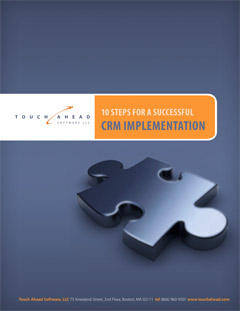 CRM (Customer Relationship Management) has been a buzzword for almost two decades now, ever since it popped up on the scene when Tom Siebel coined the phrase in 1993.1 Since then, it’s become a somewhat infamous business tool – and by that, I mean that many feel the software didn’t deliver on its promises. I would argue, as others have before me, that this is because of the approach businesses took when implementing CRM software – seeing it as a one-stop IT solution, instead of a strategy.2 It’s time to change that thought-process and start seeing CRM as a business tool, not a magical button that when pressed will increase sales and make you a billion-dollar company.
CRM (Customer Relationship Management) has been a buzzword for almost two decades now, ever since it popped up on the scene when Tom Siebel coined the phrase in 1993.1 Since then, it’s become a somewhat infamous business tool – and by that, I mean that many feel the software didn’t deliver on its promises. I would argue, as others have before me, that this is because of the approach businesses took when implementing CRM software – seeing it as a one-stop IT solution, instead of a strategy.2 It’s time to change that thought-process and start seeing CRM as a business tool, not a magical button that when pressed will increase sales and make you a billion-dollar company.
Asking the Right Questions
First of all, we must take into account the reason why businesses purchase CRM software in the first place: their bottom line. You wouldn’t invest money in something if you weren’t expecting a multi-fold return, after all, would you? Improved B2C/B2B relationships and a more organized business process are added bonuses – among many other helpful benefits that come along with having a great CRM strategy in place. In fact, a great place to start when thinking about what your CRM strategy will look like is by taking a look at your business process and asking yourself, and your employees, a few questions:
What is the communication process currently like? What methods are we using to communicate, and are those lines convoluted or barren?
What tools are we using to keep track of our daily tasks? Are they effective or just plain messy?
Sometimes we don’t realize how complex what we’re doing is until a simpler and more efficient process is forced upon us (hindsight is 20/20, as they say), so analyzing your business and educating yourself on all of the options out there is the best way to avoid getting stuck in a slow and arduous routine.
Evaluating your company will help you decide which CRM solution is the best fit and will actually deliver tangible results for your business. Do you need a system that tracks sales leads or consumers? Are you a large corporation with employees stationed nationwide? Do you do business with a multitude of companies, all in different industries or stages of development? If the answer to any of these questions was yes and you don’t already have a CRM, you might be losing business due to a slow process, which could be made faster through the use and strategic implementation of a CRM.
Best Practices
So, what exactly does this “strategy” look like? After diagnosing your business in terms of communication methods, processes and needs, then researching your CRM options, there are some overlying best practices, which Denise Holland details in her CRM Software Report, and it’s crucial that your organization is willing to commit to them before making a final decision:
“Strong executive sponsorship
A dedicated project leader
An active user community that is involved in all phases of the CRM system’s deployment and use
A phased implementation plan that delivers benefits quickly, while remaining true to the overall goals and objectives covered in subsequent phases
A balanced deployment approach that makes the right allocations of time, effort and investment among people, process and technology. Furthermore, the implementation project must balance the need to move with speed with the mandate to deploy the CRM system properly.
To provide continuous motivation, and an appropriate dose of realism, the right amount of help is required from executive sponsors, the project manager, the user community and the vendor, who should provide advisory assistance to validate the deployment approach, design choices, training methods and technical decisions”
And finally, a business best practice from me: be open and transparent with your employees. Tell them why you’ve decided to utilize a CRM and what’s in it for them. It’s one of the most important steps in administering change in an organization, and, when combined with the above steps and practices, will make your CRM strategy return unbeatable results.



